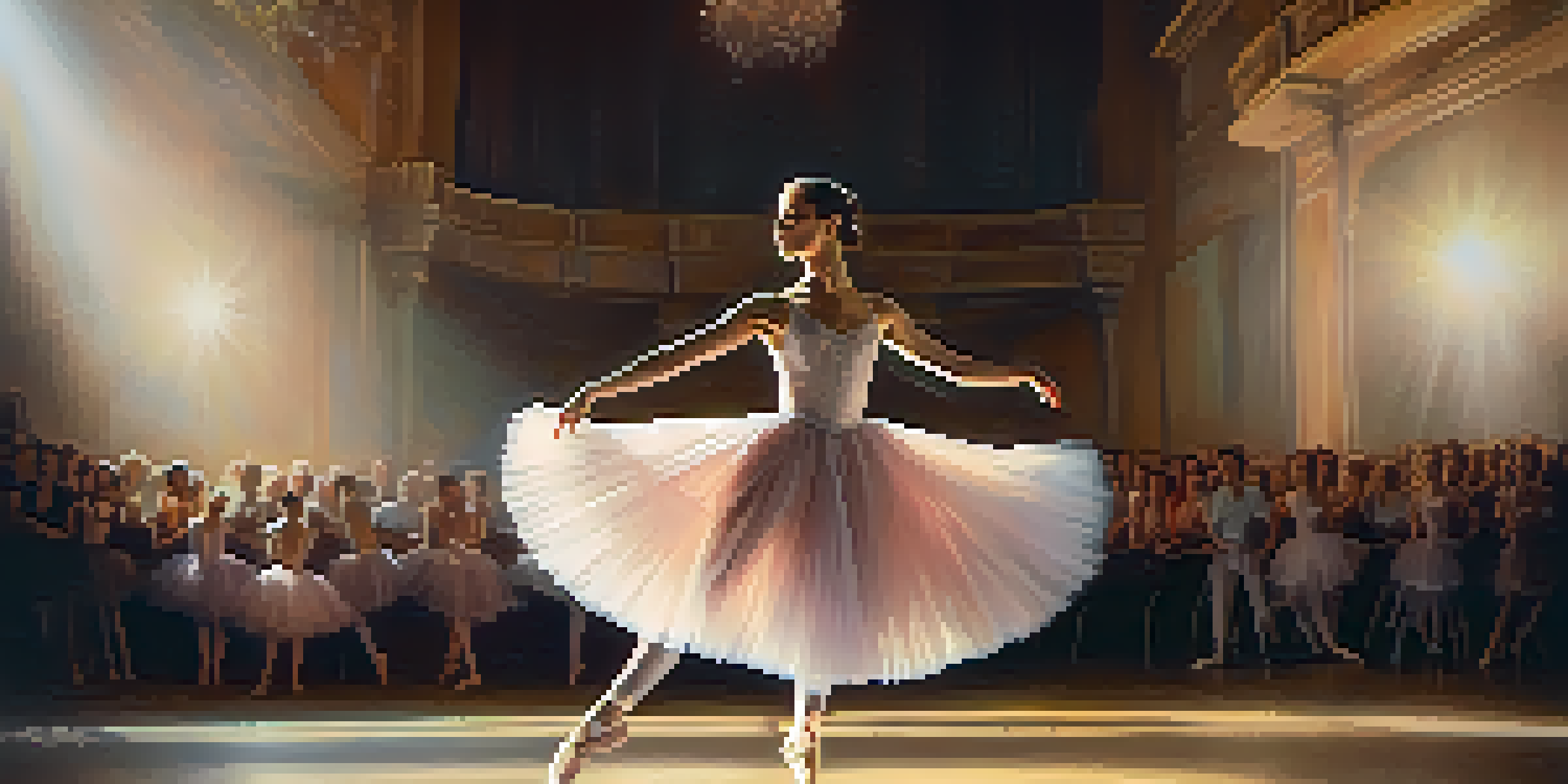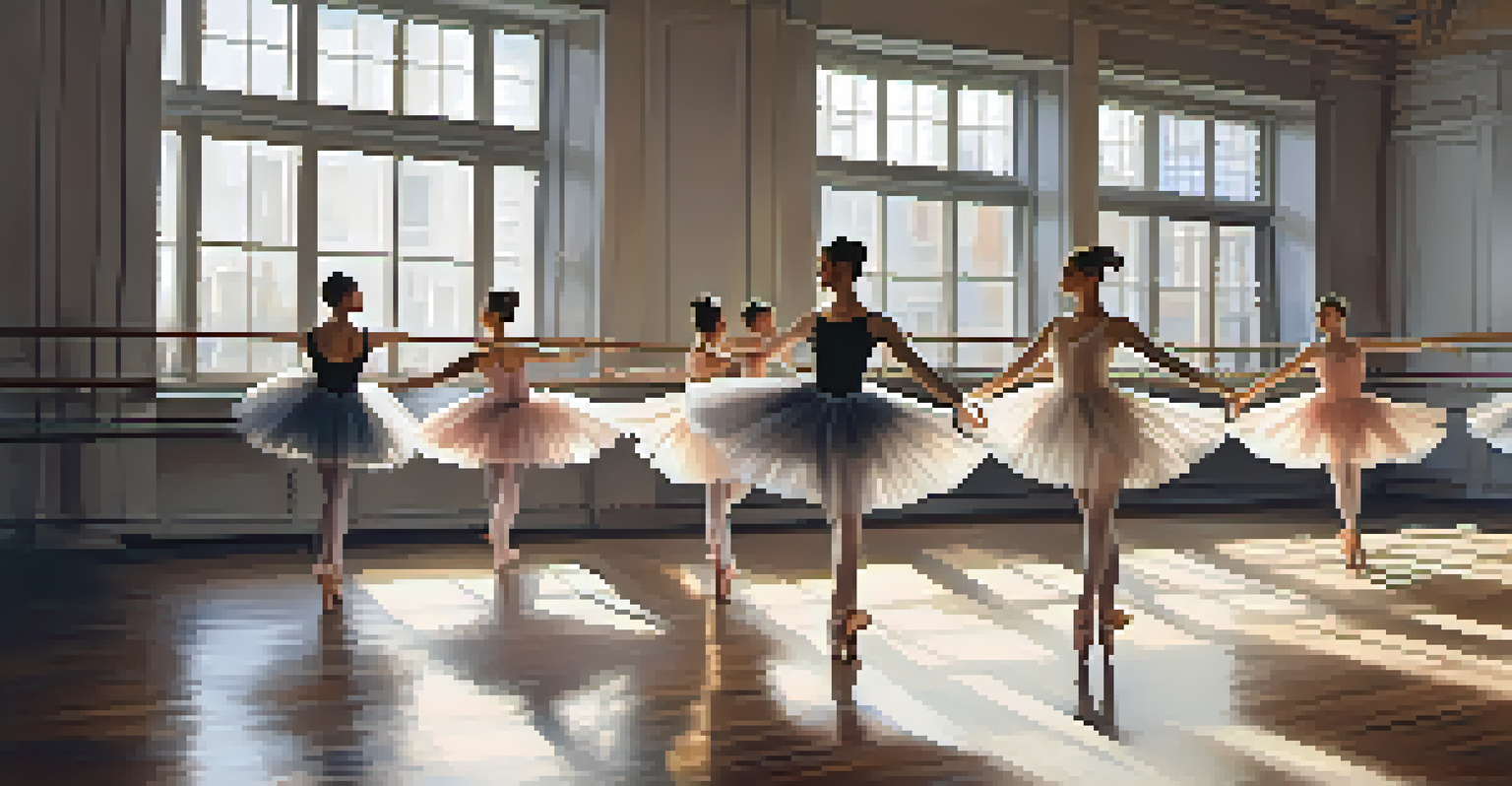The Role of Ballet in Shaping Gender Identity Perceptions

The Historical Context of Ballet and Gender Roles
Ballet has a rich history that intertwines with societal views on gender. Originating in the Italian Renaissance, it was formalized in France, where strict gender roles began to take root. Male dancers often portrayed strength and dominance, while female dancers were typically seen as delicate and graceful, reinforcing traditional gender stereotypes.
Dance is the hidden language of the soul.
This historical context sets the stage for how ballet contributes to the construction of gender identities. As ballet evolved, so too did the expectations placed on male and female dancers, often reflecting the societal norms of their times. For instance, the portrayal of women in ballet often emphasized their roles as muses and objects of desire, while men were celebrated for their athleticism.
Understanding these historical frameworks helps us see how ballet has not just mirrored, but actively shaped perceptions of gender identity. As we analyze ballet's evolution, we can better appreciate its impact on the ongoing conversation about gender and identity today.
Ballet as a Performance of Gender Norms
Ballet is not just a dance form; it's a performance that often embodies and reinforces gender norms. The costumes, movements, and narratives presented in ballet frequently reflect traditional ideas about masculinity and femininity. For example, the use of tutus and pointe shoes for women contrasts sharply with the more robust attire of male dancers, visually reinforcing gender distinctions.

These performances can perpetuate stereotypes, but they also provide a space for questioning and redefining gender roles. As contemporary choreographers incorporate diverse narratives, audiences are exposed to a broader spectrum of gender expressions. This shift encourages dancers and viewers alike to consider alternative representations of identity beyond the binary.
Ballet Reflects Gender Norms
Ballet has historically reinforced traditional gender roles, showcasing male strength and female grace through its performances.
In this way, ballet becomes a platform for exploration. While it may initially seem to uphold conventional norms, it has the potential to challenge and expand our understanding of gender identity through innovative storytelling and choreography.
The Impact of Ballet Training on Gender Identity
Training in ballet can have profound effects on a dancer's perception of their own gender identity. The discipline required in ballet often instills a sense of identity linked to both effort and artistry. As dancers learn to express emotions through their movements, they may find themselves grappling with societal expectations of how they should present their gender.
Ballet is a dance executed by the human soul.
For many dancers, this training can also foster a sense of community and belonging. Ballet studios often create supportive environments where individuals can explore their identities in a safe space. This camaraderie can lead to more open discussions about gender and identity, challenging traditional norms within the art form itself.
However, this journey is not without its challenges. Dancers may feel pressured to conform to specific gender roles, leading to internal conflicts regarding their identity. As ballet evolves, so too must the conversations surrounding identity within its training programs.
Influence of Contemporary Ballet on Gender Perception
Contemporary ballet has emerged as a transformative force in reshaping gender perceptions within the dance world. Choreographers are increasingly experimenting with non-traditional narratives that break away from classical gender roles. This shift allows for a more inclusive representation of gender identities on stage, inviting audiences to reconsider their preconceived notions.
By embracing diverse casting and innovative choreography, contemporary ballet challenges the status quo, offering new perspectives on gender. For example, productions that feature male dancers in traditionally female roles or vice versa can provoke thought and discussion about the fluidity of gender identity. This evolution reflects broader societal changes in understanding gender as a spectrum rather than a binary.
Contemporary Ballet Challenges Norms
Modern choreography is breaking away from classical gender roles, promoting diverse representations of gender identities on stage.
As contemporary ballet continues to evolve, it not only reflects cultural shifts but actively participates in the dialogue around gender identity. This engagement highlights the art form's capacity for growth and adaptation, making it a relevant and powerful medium for exploring gender issues.
Ballet's Role in Challenging Gender Stereotypes
Ballet has the potential to challenge and subvert traditional gender stereotypes through innovative storytelling. Productions that focus on themes of empowerment, resilience, and individuality allow dancers to portray a wide range of identities. This approach encourages both performers and audiences to rethink what gender means within the context of art.
For example, works that depict strong, multifaceted female characters can shift perceptions of femininity, showcasing women as powerful and complex rather than simply graceful. Similarly, male characters that embody vulnerability and emotional depth challenge the rigid ideals of masculinity that have long dominated the stage.
By redefining these roles, ballet can contribute to a broader cultural conversation about gender equality and representation. This transformation not only enriches the art form but also resonates with audiences, inspiring them to reflect on their own beliefs about gender identity.
The Role of Audience Perception in Ballet
Audience perception plays a crucial role in how ballet shapes and reshapes gender identity perceptions. The expectations that viewers bring to a performance can influence their interpretations of characters and narratives. For instance, an audience accustomed to traditional gender portrayals may initially struggle to accept a more fluid representation of gender on stage.
However, as audiences become more aware of diverse gender identities, their perceptions can shift. This evolution is evident in discussions surrounding recent productions that challenge norms, where viewers express appreciation for the complexity and authenticity of the performances. Such feedback can encourage ballet companies to continue exploring innovative narratives.
Audience Shapes Gender Perception
The perceptions and expectations of audiences significantly influence how gender identity is interpreted in ballet performances.
Thus, the relationship between ballet and its audience is dynamic and ever-evolving. As audiences embrace new perspectives, ballet can serve as a catalyst for change, encouraging broader acceptance of diverse gender identities and experiences.
Future Directions for Ballet and Gender Identity
Looking ahead, the future of ballet in relation to gender identity appears promising yet challenging. With the ongoing push for inclusivity and diversity in the arts, there is a growing movement to redefine what ballet can represent. This includes expanding the narratives told on stage and ensuring that a variety of gender identities are represented.
Choreographers and dancers are increasingly advocating for change, collaborating with communities to create works that reflect a broader spectrum of experiences. Initiatives that focus on mentorship and support for underrepresented voices in ballet are crucial for fostering an inclusive environment. These efforts not only enrich the art form but also empower individuals to express their authentic selves.

As ballet continues to evolve, it will be essential to maintain open dialogues about gender identity. By prioritizing inclusivity and challenging traditional norms, ballet can play a vital role in shaping a more equitable future for all dancers, regardless of their gender identity.